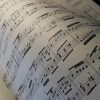DIY Magnetic Sheet Music Tutor
While we tend to focus on the scientific and mathematical side of life, we still love the arts! That’s the great thing about magnets—they’re useful almost everywhere. With that in mind, we thought we’d turn our attention to music. Specifically, those learning to sing or play an instrument.
One of the first things all musicians need to learn is how to read notes and other symbols found on a page of sheet music. This can often be tricky, especially if it’s totally new. Luckily, we've got a simple DIY to help anyone learn the various parts of a musical staff and where they appear.
Here’s what you’ll need:
- Black construction paper
- Scissors
- Contact paper or laminate
- Old cookie sheets or other pans (the flatter the better)
- White paint
- Black paint
- Adhesive Disc Magnets
- Notes (whole, half, quarter, eighth)
- Rests (whole, half, quarter, eighth)
- Time signatures (common, cut, ¾, etc.)
- Accidentals (flats, sharps, naturals)
- Clefs (treble, bass)
- Dynamics (forte, mezzoforte, piano, etc.)
- Any other symbols (breaths, slurs, trills, codas, repeat)

